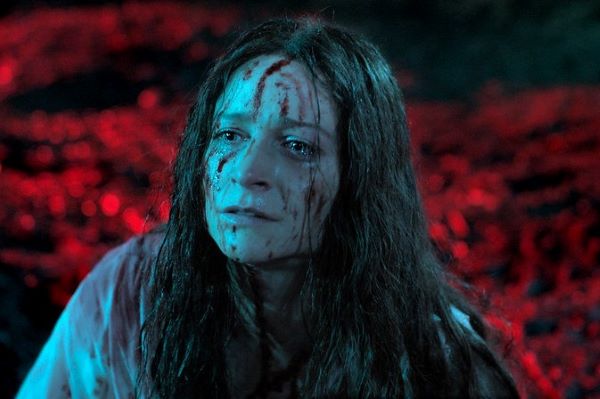Diving into the period of the video nasties gives a pleasurable shiver to any British horror fan of a certain age. Genre film has been raiding the 1980s with the enthusiasm of a grubbing family at the death of a rich relative, with returns that are beginning to diminish. Few reach a Proustian hand back to rifle through the sensationalism of the period itself. Censor, the debut feature from Prano Bailey-Bond does just that. A psychological horror that is as fascinated by the social and political background that spawned the media furore than by the films themselves, it’s a sly and mischievous work, made with a fetishist’s eye. It may be a somewhat slight tale when detached from the heady nostalgia that bubbles from every frame, but for the audience it’s very specifically addressing it’s endlessly intoxicating.
Enid (Niamh Algar) is a dedicated and meticulous film censor who scans every frame of each gorefest that arrives before her. It is her self-imposed mission to defend the viewing public from the potentially harmful effects of these films, an act of endless penance for her guilt over the disappearance of her younger sister when they were children. Enid was present but cannot recall the events of the evening apart from hazy half-memories of a forest and a creepy cabin. Just as the certificate arrives that finally declares sister dead in absentia, Enid reviews a film that seems to uncannily mirror the events of the night her sister vanished. Enid goes in search of the filmmaker, certain she will find the answers lost in her past.
Right from the off, Bailey-Bond and her production team are tickling that hippocampus as the production logos appear crackling through the distressed tracking of a knackered VHS. It’s followed by credits that intercut infamous scenes from the likes of Driller Killer and Nightmare in a Damaged Brain with scenes of Thatcher’s Britain, various archive reports on the video nasties and their effects, and the ubiquitous Mary Whitehouse. In fact, our protagonist Enid (played by Algar with a redirection of the forceful rigidity she displayed in the recent Calm with Horses) seems to have referred to Saint Mary as something of a style guru. With her evident youth held hostage by a tight bun, drably functional polyester, and spectacles worn on a chain, she’s every inch the stentorian moral guardian. Very at home in the impeccably rendered settings of chunky electronics, dreadful wallpaper, and muted furnishings in the same tones as the outfits of those who sit in them.
Censor isn’t mining the same ’80s pup culture vein as the likes of Stranger Things or It. Rather, it’s the arty strand of retro-appreciation in which the likes of Peter Strickland dwell. Bailey-Bond’s film shares much DNA with the Berbarian Sound Studio, and especially In Fabric. Where Strickland begins from a heightened, distorted, almost Lynchian vision of reality however, Censor is set firmly, to begin with at least, in the more quotidian nightmares of mass unemployment, Orgreave, and the media’s relentless blaming of anyone except those in power. It’s only much later, when Enid’s sense of reality has become as warped as the picture on a fifth-gen pirate copy of The Evil Dead that surreal colour seeps in like the misty halogen glow of a Winding Refn or a Cosmatos.
Looking at Censor from a thematic perspective, the idea of a need for censorship in general is an interesting one. It presupposes that there is material from which the public needs to be shielded. Logically therefore, noone is more exposed to that material than the censors themselves. It’s an avenue that hasn’t often been explored, perhaps because to base a horror film on the premise that over-exposure to gory imagery will indeed drive you insane would be counter-intuitive. The one example in memory that operates on a similar theme is the dismal ’90s film Evil Ed, a pale imitation of the splatter it homages. Still, the horror genre is often historically conservative in subtext, so a plot that reads like a Daily Mail headline come to garish life isn’t particularly out of step. Hell, it worked nicely for Eden Lake.
What is clear is that Bailey-Bond is operating with a keen sense of irony; there are moments that puncture media scapegoating – a supposed copy-cat murder that eerily echoes the completely spurious link made between Child’s Play 3 and the awful Jamie Bulger case is revealed to be nonsense – just as Enid’s grip on reality is correspondingly beginning to fray. Censor assumes that the viewer has the knowledge of that constant tension between physical media and print media’s suspicion of it. Not that the film doesn’t work without it, but there is a wealth of cultural subtext that adds endless value to one’s enjoyment. With a great central performance and a raft of familiar faces like the criminally unacknowledged national treasure Michael Smiley, Nicholas Burns, and Vincent Franklin, those who can tap into the lurid period texture will find a future favourite, and no doubt an urge to revisit the violent delights that inspired it.
Screened as part of Sundance Festival 2021
